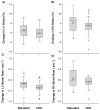Hyperinsulinemic Normoglycemia Does Not Meaningfully Improve Myocardial Performance during Cardiac Surgery: A Randomized Trial
- PMID: 26200180
- PMCID: PMC4511921
- DOI: 10.1097/ALN.0000000000000723
Hyperinsulinemic Normoglycemia Does Not Meaningfully Improve Myocardial Performance during Cardiac Surgery: A Randomized Trial
Abstract
Background: Glucose-insulin-potassium (GIK) administration during cardiac surgery inconsistently improves myocardial function, perhaps because hyperglycemia negates the beneficial effects of GIK. The hyperinsulinemic normoglycemic clamp (HNC) technique may better enhance the myocardial benefits of GIK. The authors extended previous GIK investigations by (1) targeting normoglycemia while administering a GIK infusion (HNC); (2) using improved echocardiographic measures of myocardial deformation, specifically myocardial longitudinal strain and strain rate; and (3) assessing the activation of glucose metabolic pathways.
Methods: A total of 100 patients having aortic valve replacement for aortic stenosis were randomly assigned to HNC (high-dose insulin with concomitant glucose infusion titrated to normoglycemia) versus standard therapy (insulin treatment if glucose >150 mg/dl). The primary outcomes were left ventricular longitudinal strain and strain rate, assessed using speckle-tracking echocardiography. Right atrial tissue was analyzed for activation of glycolysis/pyruvate oxidation and alternative metabolic pathways.
Results: Time-weighted mean glucose concentrations were lower with HNC (127 ± 19 mg/dl) than standard care (177 ± 41 mg/dl; P < 0.001). Echocardiographic data were adequate in 72 patients for strain analysis and 67 patients for strain rate analysis. HNC did not improve myocardial strain, with an HNC minus standard therapy difference of -1.2% (97.5% CI, -2.9 to 0.5%; P = 0.11). Strain rate was significantly better, but by a clinically unimportant amount: -0.16 s (-0.30 to -0.03 s; P = 0.007). There was no evidence of increased glycolytic, pyruvate oxidation, or hexosamine biosynthetic pathway activation in right atrial samples (HNC, n = 20; standard therapy, 22).
Conclusion: Administration of glucose and insulin while targeting normoglycemia during aortic valve replacement did not meaningfully improve myocardial function.
Figures






Comment in
-
Happy 53rd Birthday GIK: Insulin, Cake, and Presents.Anesthesiology. 2015 Aug;123(2):249-50. doi: 10.1097/ALN.0000000000000724. Anesthesiology. 2015. PMID: 26200177 Free PMC article. No abstract available.
References
-
- Duncan AI, Lowe BS, Garcia MJ, Xu M, Gillinov AM, Mihaljevic T, Koch CG. Influence of concentric left ventricular remodeling on early mortality after aortic valve replacement. Ann Thorac Surg. 2008;85:2030–9. - PubMed
-
- Mehta RH, Bruckman D, Das S, Tsai T, Russman P, Karavite D, Monaghan H, Sonnad S, Shea MJ, Eagle KA, Deeb GM. Implications of increased left ventricular mass index on in-hospital outcomes in patients undergoing aortic valve surgery. J Thorac Cardiovasc Surg. 2001;122:919–28. - PubMed
-
- Sambandam N, Lopaschuk GD, Brownsey RW, Allard MF. Energy Metabolism in the Hypertrophied Heart. Heart Failure Reviews. 2002;7:161–73. - PubMed
-
- Schonekess BO, Allard MF, Lopaschuk GD. Recovery of glycolysis and oxidative metabolism during postischemic reperfusion of hypertrophied rat hearts. Am J Physiol. 1996;271:H798–805. - PubMed
-
- Eberli FR, Weinberg EO, Grice WN, Horowitz GL, Apstein CS. Protective effect of increased glycolytic substrate against systolic and diastolic dysfunction and increased coronary resistance from prolonged global underperfusion and reperfusion in isolated rabbit hearts perfused with erythrocyte suspensions. Circ Res. 1991;68:466–81. - PubMed
Publication types
MeSH terms
Substances
Grants and funding
LinkOut - more resources
Full Text Sources
Other Literature Sources
Medical

